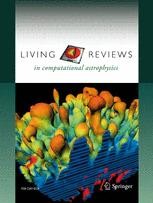Living Reviews in Computational Astrophysics: "Vlasov methods in space physics and astrophysics"
 Palmroth, M. et al., "Vlasov methods in space physics and astrophysics", Living Rev Comput Astrophys (2018) 4: 1. https://doi.org/10.1007/s41115-018-0003-2
Palmroth, M. et al., "Vlasov methods in space physics and astrophysics", Living Rev Comput Astrophys (2018) 4: 1. https://doi.org/10.1007/s41115-018-0003-2
Open Access | Review Article
First Online: 16 August 2018
"This article reviews numerical methods for solving the Vlasov equation on a grid (in the context of astrophysical plasmas). It then describes the design decisions made in implementing the newly developed code Vlasiator. In addition, some physics and HPC aspects are discussed as well. This manuscript is very well written, gives a good overview of the relevant physics, the literature on numerical algorithms, as well as their efficient implementation
Abstract:
This paper reviews Vlasov-based numerical methods used to model plasma in space physics and astrophysics. Plasma consists of collectively behaving charged particles that form the major part of baryonic matter in the Universe. Many concepts ranging from our own planetary environment to the Solar system and beyond can be understood in terms of kinetic plasma physics, represented by the Vlasov equation. We introduce the physical basis for the Vlasov system, and then outline the associated numerical methods that are typically used. A particular application of the Vlasov system is Vlasiator, the world’s first global hybrid-Vlasov simulation for the Earth’s magnetic domain, the magnetosphere. We introduce the design strategies for Vlasiator and outline its numerical concepts ranging from solvers to coupling schemes. We review Vlasiator’s parallelisation methods and introduce the used high-performance computing (HPC) techniques. A short review of verification, validation and physical results is included. The purpose of the paper is to present the Vlasov system and introduce an example implementation, and to illustrate that even with massive computational challenges, an accurate description of physics can be rewarding in itself and significantly advance our understanding. Upcoming supercomputing resources are making similar efforts feasible in other fields as well, making our design options relevant for others facing similar challenges.
